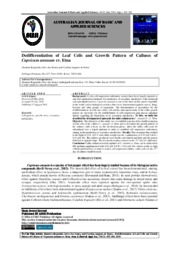Dedifferentiation of Leaf Cells and Growth Pattern of Calluses of Capsicum annuumcv. Etna.
Dedifferentiation of Leaf Cells and Growth Pattern of Calluses of Capsicum annuumcv. Etna.
Autoria: SANTOS, M. R. A. dos; SOUZA, C. A. de
Resumo: Background:In vitrocell suspension cultivation systems have been largely reported assafe and standardized methods for production of secondary metabolites with medicinaland agricultural interest.Capsicum annuumis one of the most widely grown vegetablein the world and its biological activities have been demonstrated against insects, fungi,bacteria and other groups of organisms. The determination of procedures for thededifferentiation of cells into callus cells and the subsequent study of the callus growthpattern are necessary for the establishment of cellsuspensions and also to subsidizestudies regarding the bioactivity of its secondarymetabolites. To date, no study hasdescribed the development of protocols for callus induction inC. annuumL. cv. Etna. Objective:The objective of this study was to establish a protocol for dedifferentiationof leaf cells of the cultivarC. annuumcv. Etna and to determine the growth pattern ofthe calluses with a focus on the deceleration phase, when the callus cells must besubcultured into a liquid medium in order to establish cell suspension cultivationsaiming at the production of secondary metabolites.Results:The treatment that resultedin the highest %CI, ACCC and callus weight was thecombination of 4.52 μ M 2,4-D +0.44 μ M BA. The calluses produced were friable andwhitish and their growth patternfollowed a sigmoid shape. The deceleration phase started on the 23rdday of cultivation.Conclusion:Callus induction in leaf explants ofC. annuumcv. Etnacan be achieved inMS medium supplemented with 4.52 μ M 2,4-D + 0.44 μ MBA, which results in highcellular proliferation; in order to start a cell suspension culture, callus cells on the 23rdday of culture should be used.
Ano de publicação: 2016
Tipo de publicação: Artigo de periódico
Unidade: Embrapa Rondônia
Palavras-chave: Callogenesis, Calogêneses, Curva de Crescimento, Growth curve, Metabolismo secundário, Pimenta, secondary metabolites
Observações
1 - Por padrão são exibidas publicações dos últimos 20 anos. Para encontrar publicações mais antigas, configure o filtro ano de publicação, colocando o ano a partir do qual você deseja encontrar publicações. O filtro está na coluna da esquerda na busca acima.
2 - Para ler algumas publicações da Embrapa (apenas as que estão em formato ePub), é necessário ter, no celular ou computador, um desses softwares gratuitos. Sistemas Android: Google Play Livros; IOS: iBooks; Windows e Linux: software Calibre.
Acesse outras publicações
Acesse a Base de Dados da Pesquisa Agropecuária (BDPA) para consultar o acervo completo das bibliotecas da Embrapa.

